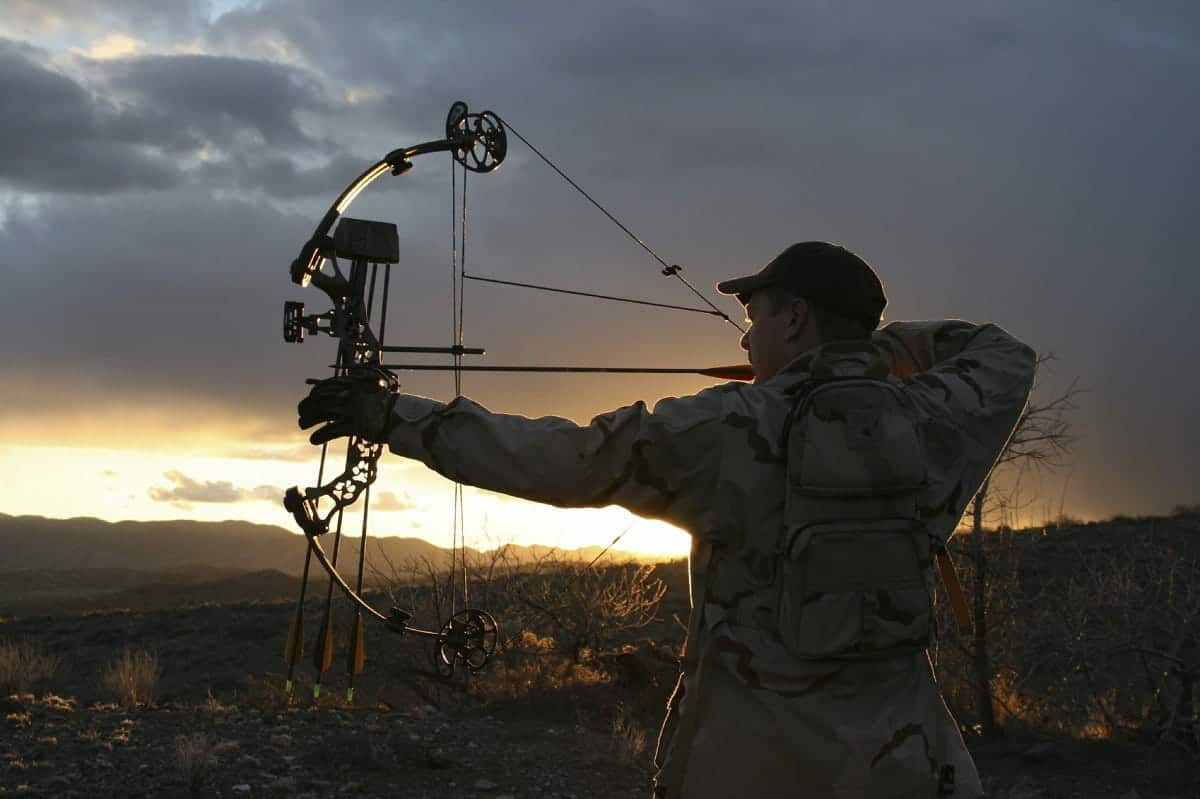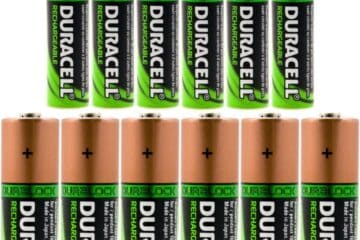Backpacking is one of the most comprehensive workouts a person can do (1). Successful backpacking relies heavily on a few foundational pieces of gear: hiking boots, a good backpack and a great backpacking sleeping bag.
Without the right boots every step will be harder than it needs to be. Without the right backpack hiking for hours on end will become a painful ordeal. And without the right sleeping bag you won’t be able to get the restful sleep you need to continue on with your adventure in a safe, enjoyable manner.
We’ve looked at hundreds of sleeping bags and whittled our choices down to the following 10 which we believe represent the best backpacking sleeping bags on the market today.
1. Kelty Tuck 22F Degree Mummy Sleeping Bag
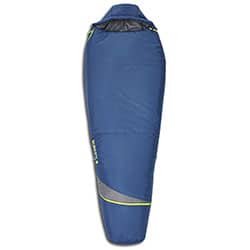
Kelty’s combination of performance, build quality, comfort and affordability will not be denied. This is an ultra-warm 3 season bag and one that displays admirable compressibility. It’s covered in a durable 75D polyester taffeta shell and features ThermaPro insulation. The 22 degree Fahrenheit rating seems a bit conservative.
But regardless, it will keep you comfy warm on all but the coldest nights. Should you find it’s a bit too warm for conditions you can always unzip the footbox and vent some heat in a controlled manner. There’s a secure pocket inside to stow your smartphone and pull cords around the face opening for those really cold night. Best of all it stays warm even when damp.
2. TETON Sports TrailHead Ultralight Mummy Bag

If you’re hiker on a budget you’re going to find a lot to like in the Teton Sports TrailHead Mummy Bag. There’s a water-resistant shell, a vaulted footbox that allows more heat to gather, innovative microfiber insulation that stays warm even when wet and a comfortable double-brushed liner that feels more like your regular bed than a sleeping bag.
The zippers are top-quality, compressibility is good and the weight of the bag is a very agreeable 2.9 pounds. The bag is rated to 20 degrees Fahrenheit, which our testing indicates is just about right. Although that baseline rises considerably should the bag get wet. The bag is 87 inches long, which is good news for tall folks. And all Teton bags come with a limited lifetime warranty.
3. Nemo Sonic 0-Degree Down Mummy Bag

Nemo may not be a household name but their reputation within the climbing community is well-deserved. Headquartered in New Hampshire, home of outstanding winter mountaineering (2) and ice climbing, they have the ability to put they put all their bags to the test right in their own backyard. Their Sonic 0 degree Fahrenheit Down Mummy Bag is one of the best on the market for a slew of reasons.
It weighs a feather-like 2 lbs 10 ounces, compresses down to about the size of a rolled-up sweater and stretches at the knees to enable greater comfort within. On a calm night with a good sleeping pad you can probably feel comfy down to -10 Fahrenheit. Loft is outstanding, the shell is light but tough and the zippers will stand the test of time. You’re going to pay for the quality on display here but you’ll benefit from it too.
4. Hyke & Byke Hydrophobic Sleeping Bag

Hyke & Byke is a relatively new company out of Colorado started by a group of engineers. These folks have made it their mission to offer the highest quality climbing and backpacking gear at the best possible prices. One way they keep costs down is to partner with Amazon for storage and sales. Another is to keep the company small and private so there are no shareholders demanding ever greater profits.
Their equipment is quickly becoming must-have gear for hikers and climbers of all ages and skill levels. And their Hydrophobic Sleeping Bag is a great example of why that is. It’s light (3.4 lbs) uses waterproof fabrics and warm-when-wet microfiber insulation. The bag has an 0 degree rating and extra long versions are available for hikers up to 6’ 6” tall.
5. Mountain Hardwear 0 Degree Lamina Sleeping Bag

Mountain Hardware earns a spot on our list with their outstanding 0 degree Fahrenheit Lamina Sleeping Bag. The Lamina features Thermal.Q insulation, has a shell fashioned from 30D ripstop nylon and polyester and will comfortably accommodate someone up to 6’ 6” tall. The Lamina boasts a trim mummy profile, a durable no-stick zipper, has a reinforced bottom to protect against debris on the tent floor and will stay warm even if the bag gets wet.
That’s a benefit of the Thermal.Q insulation. The Lamina weighs a bit more than comparable down filled bags. That’s also a function of the insulation. What you have to weigh is whether the ability to stay warm when wet is worth the extra pound or two.
6. Nemo Men’s Disco Down Sleeping Bag

Nemo makes another appearance on our list of best backpacking sleeping bags with their Disco Down Bag. The curiously named bag comes in 15 and 30 degree variations that each feature the company’s unique spoon shaped (more like hourglass shape actually) design.
There are expandable baffles at the knees to allow for greater comfort and a reinforced and waterproof footbox. Like the Nemo Sonic we looked at a few moments ago the Disco weighs less than 3 lbs. Making it an attractive option for backpackers of all ages. But while the Disco is undeniably warm, light and room it’s also a bit bulkier than some other bags. Meaning you may have to leave something out to make room for it in your pack. Everything has a downside.
7. Marmot Trestles Cold Weather Sleeping Bag

Marmot is a name experienced backpackers will know well. And while they no longer rule the hiking equipment roost the way they once did they continue to produce high-quality outdoor sleeping gear like the Trestles Cold Weather Sleeping Bag.
The Trestles boasts clean lines, a durable shell a high-quality stuff sack and SpiraFil synthetic insulation that keeps the heat on down to 15 degrees Fahrenheit. It has a classic mummy bag shape with tapered, reinforced footbox and a pull cord around the head opening for those really cold nights. This is a great 3 season bag that will also provide plenty of cover in less than extreme winter locales. It may be the best 3 season bag on the market at this price.
8. Mountain Hardwear Phantom Flame Sleeping Bag
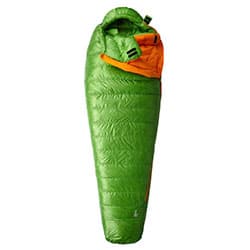
Mountain Hardware bags are testaments to the state of the art. The Phantom Flame weighs only 2 lbs. Only 1/3 what some other similarly-rated bags on our list weigh. It’s rated to 15 Fahrenheit but can be pushed to 0 with the right sleeping pad and occupant. The loft you get from the goose down is impressive all the way from footbox to hood. The hood is broken up into 6 chambers that distribute the insulation more evenly around your noggin than most other bags.
Compressibility is also impressive, leaving plenty of room for other items. Should you be disposed to taking any. You’re going to pay more for the Phantom Flame but when you’re bounding up the mountain or across the ridge with your nice light pack you’ll be glad you did.
9. CANWAY Sleeping Bag
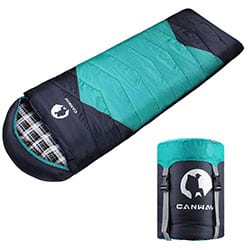
Not everyone goes backpacking in during the late fall and winter and for those who prefer warm weather hiking the Canway Sleeping Bag will provide more than adequate cover at an attractive price. The Canway sports a traditional rectangular profile, is filled with hollow cotton and will keep you comfy down to about 40 F.
This is a no-frills recreational bag that stuffs away reasonably small, weighs a modest 4.2 lbs and does a good job repelling water. It’s comfortable as is and much more comfortable with a nice blow-up sleeping pad. It won’t break your bank or let you down on those cool summer nights.
10. Nemo Women’s Cleo 3 Season Down Sleeping Bag
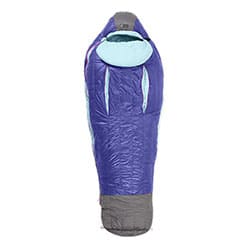
We go back to the Nemo well one more time for their outstanding Women’s Cleo 3 Season Down Bag. Tipping the scales at at rim 2.4 lbs the Cleo is designed with the specific needs of women in mind. For physiological reasons women typically need a bit more cold weather support from their bags and the Cleo provides it.
It’s filled with Nikwax Hydrophobic down that keeps the heat cranking right down to 30 Fahrenheit. There are expansion baffles at the knees, a “blanket fold” for pulling over your head on really cold nights and the waterproof footbox will repel condensation in the tent (3) so your feet stay dry and warm and ready to go in the morning.
FAQs
What are the Different Kinds of Bags?
Most sleeping bags are rated as either summer bags, 3 season bags (spring, summer and fall) or cold weather/winter bags. Summer bags are just that. Trying to get by with one in the spring or fall will likely lead to a long uncomfortable night. And trying to use one is the winter could lead to hypothermia and even death. Let’s take a closer look at the characteristics of the different bags.
- Summer bags – A summer bag is little more than a quilt with a zipper. And a fairly light quilt at that. You use them on sweltering hot nights to put some cushioning beneath you and perhaps to keep the mosquitos from eating you alive. Typically these bags are rated to 32 Fahrenheit. But frankly that’s pushing it. Where they shine is when it’s in the 40s or 50s F outside. Any cooler you may need a sweater inside. Any hotter you may have to sleep on top of the bag.
- Three season bags – Three season bags are normally rated down to 20 degrees Fahrenheit and many will be perfectly serviceable down to 15 or even 10. It largely depends on the person in the bag. Some people endure cold better than others (4). If you’re not a big fan of icy weather you shouldn’t push your luck. You may be thinking that a lot of winter nights where you live don’t get much below 20 Fahrenheit. And you may be right about that. The thing is, once you get away from the city, and especially when you are hiking at elevation, things change significantly (5). A 20 degree Fahrenheit night in your city neighborhood is bound to be more like 0 Fahrenheit in the mountains. Maybe even -10 F. So you can’t make your bag decisions based on the weather where you live. That decision has to be based on the weather where you’re going.
- Winter bags – Winter hiking is not for the unprepared, the feint of heart or the foolhardy. People die from exposure all too often in the mountains during December, January and February. A pleasant jaunt through a pristine forest glistening with new snow can turn into white out conditions, howling winds, plummeting temperatures and a battle for survival in in just a matter of minutes (6). If winter’s worst descends you have to be ready and able to set up shelter quickly and hunker down to ride it out. If your bag is not up to the task of keeping you warm nightmare conditions outside the tent can quickly turn into nightmare conditions inside the tent. And, unless you have a death wish, don’t think you can just fire up the stove inside the tent to keep warm. The bottom line is that a winter bag should be able to handle 0 degrees Fahrenheit without blinking.
What Should You Look for in a Backpacking Sleeping Bag?
If you have any hope of having an enjoyable overnight hiking experience it’s crucial that your sleeping bag be up to the task. There are certain considerations that come into play regardless of the time of year. And if you’re on the mountain during the cold weather months an additional set of factors come into play. Selecting the wrong bag could end up undermining both your safety and enjoyment. So it all begins with knowing what to look for in a sleeping bag.
- Weight – We hear people all the time saying “We were carrying 100 pound packs!” Uh, with all due respect, balderdash! The only people who carry 100 pound packs are Sherpas. Virtually everyone would have to end their hike after a couple of hours if they were carrying even 50 or 60 pounds. The fact is, most people heading into the woods for a few days carry between 25 and 40 pounds (7). And that’s a lot when it’s slung to your back all day long. So you need to reduce weight wherever possible. And weight reduction starts with the major weight contributors: food, sleeping pad, tent and sleeping bag. When it comes to your sleeping bag the lighter the better. As long as the bag has an adequate rating to handle the projected weather where you’re going.
- Compressibility – Another concern is making sure everything you need fits into your backpack. Sleeping bags are notorious space hounds. Gobbling up precious volume within the pack. As a general rule compressibility goes hand in hand with price. That’s because the warmest, most compressible materials are also the most expensive. Paying a few bucks extra for a highly compressible bag though can pay handsome dividends. There will be more room for an extra sweater, backup socks and a bit more food in case you wind up stranded.
- Style – Most summer bags sport the traditional rectangular design that’s been with us for over a century. When it comes to 3 season and winter bags however, mummy bags are the way to go. Why? Because the tapered design of the mummy bag reduces weight. It also allows the bag to compress smaller so you have more room in the backpack for other things. Tapering also tends to eliminate cold pockets inside the bag that can make things uncomfortable on really cold nights. When it comes to length tall people have rightfully complained for decades that most bag makers don’t design for anyone over 6 feet tall. Lately, however, some companies have finally stepped up and are offering longer than average bags for tall folks.
- Temperature rating – There are a lot of factors that go into determining a person’s comfort. Temperature rating is certainly one of them. But remember: a person with a bag rated to 0 degrees F and an outstanding sleeping pad under them will be warmer than another person with the exact same bag and no sleeping pad. Also, people with fast metabolisms tend to fare better in cold weather because their internal engine is always cranking out heat. While people with slower metabolisms will be more sensitive to cold. A good rule with temperature ratings then is “better safe than sorry”. If you’re too warm you can always open the zipper and vent heat. If you’re too cold you’re just going to have to live with it.
- Wet warmth – If you spend a lot of time in the outdoors there are going to be times when your bag gets wet. When this happens your choices are limited. You can’t sleep in a wet bag after all. Or can you? Well, if your bag is full of soaking-wet down the answer is likely “no”. In such a case you may need to consider cutting your trip short. Unless you have some way to dry it out. On the other hand some synthetic fillers dry out quicker than down and some retain their ability to provide warmth even if wet. Sort of like wool. Still, no bag is going to be comfortable if it’s wet. Some may well provide some warmth, but it will be a very uncomfortable warmth.
- About EN ratings – You hear a lot these days about EN ratings (8). EN or European Norm is a temperature rating system employed by many European manufactures. However, many US companies and even some European companies don’t use the system. And it’s easy to understand why. The system often seems unnecessarily complex and confusing.
Which is Better: Down or Synthetic Insulation?
The down vs synthetic debate has raged for decades across multiple applications. Down winter coats are almost always considered superior to others. But wool is extremely warm, especially if you dress in layers, and will stay warm even if you get caught in a cold rain. Let’s see how the down vs other materials plays out with sleeping bags.
- Down – Down (9) has a clear edge when it comes to cold weather bags. It’s light, compressible and extremely warm. And, because we’re talking bone-chilling winter weather that bag isn’t likely to get wet enough to compromise performance. So give the edge to down in the winter time. Keep in mind though that down is almost always more expensive than synthetic fillers.
- Synthetics – If synthetics have an advantage besides price its in warm weather bags. If you spend a lot of time camping in the warm weather months you stand a much better chance of being caught in a downpour or waking up to find water in the tent after a night of rain. In these cases having a bag with synthetic fill can be an advantage because it will likely dry out faster than a down bag will. And even if it is not 100% dry by the time you need to go to sleep it will keep you a bit warmer than a damp down bag would.
So in the broadest possible terms, down for cold weather, synthetic for warm weather.
The Bottom Line
The best backpacking sleeping bags are light, compressible, warm and durable. They’ll help you get the good night’s sleep you need to recover from a strenuous day on the trail and they’ll be your lifeline when extreme weather descends on you. Any of the bags we profiled above should serve you well. Just make sure you choose one that’s rated to the weather where you’re going. And for your own sake don’t try to “make do” with something less. Remember, you usually don’t get a 2nd chance to make a big mistake in the woods or on the mountain.

